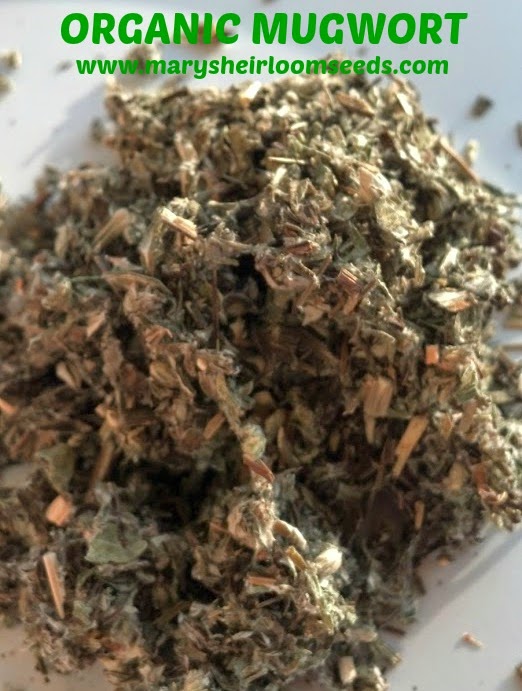Growing Organic Mugwort from Seed to Harvest Posted on 28 Nov 06:36 , 3 comments
 |
| Mugwort |
Even though it has so many medicinal properties, it should not be used by lactating women as this herb can pass through milk to the infant. Since the leaves are bitter in taste, they are used as a bitter flavoring agent in foods to season meat, fish, and fat. It is also used on roasted goose which is done for Christmas. It is used by the Chinese and Japanese in many foods such as juices and rice cakes. It has many essential oils such as thujone, wormwood, and cineole. Mugwort also contains derivates of coumarin, triterpenes, and flavonoids. This herb has found its use as an insect repellent too to eliminate moths from fields and gardens. It is also used as a smudging herb for divination.

Available NOW at Mary's Heirloom Seeds
Harvest mugwort shortly before it flowers and hang the leafy steps upside down in a dry place away from sunlight to dry.
Collect the root in autumn. Wash and dry mugwort root thoroughly and lay it on a screen to dry. Do not let the roots touch one another or they may mold.
We have DIY Mugwort Tincture Kits at Mary's Tincture Shop!
Tincture kits include:
1 - 32 ounce Glass Jar with lid, 1 - 2 ounce Amber Bottle with dropper top,
2 customizable labels, 1 ounce of Organic Herbs (additional herbs available)
and Detailed Instructions
Infusion - 1 ounce dried herb to 1 pint boiling water. 5-10 minutes. Do not make steep for too long or it will become intolerably bitter.
TINCTURE: 1 ounce dried herb & 3-5 cups menstruum (liquid: vodka, everclear, ACV or vegetable glycerin)
**Complete instructions coming soon**
Disclaimer: Should not be taken if pregnant or nursing. Not as a substitute for professional medical prevention, diagnosis, or treatment. Please consult with your physician, pharmacist, or health care provider before taking any home remedies or supplements or following any treatment suggested by anyone on this site. Only your health care provider, personal physician, or pharmacist can provide you with advice on what is safe and effective for your unique needs or diagnose your particular medical history.
Sign up for our E-Newsletter


Comments
Nancy Godwin🐬 on
First time growing mugwort. Is it OK to harvest it after it flowers.?
Nancy Godwin🐬 on
First time growing mugwort. Is it OK to harvest it after it flowers.?
Suzy Bottomley on
A friend who recently started keeping bees gave me some honey he collected last fall. It was a taste I felt I remembered as a smell …
Then I remembered mugwort. I had collected it for smudging but I remembered it has been used to flavor ales ..
The honey was quite unique, and different too from the honey I got this spring from the same source .
I bought seeds for me and for him but I forgot to plant them😐.
I suppose I’m too late….will they be ok for fall?